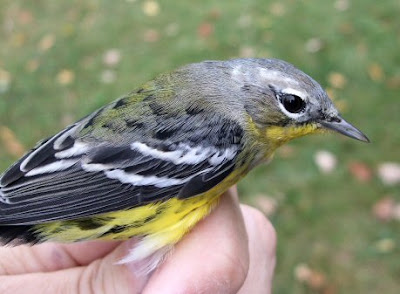
Last fall, I
described the focus of my research: the autumn stopover ecology of migrant thrushes. My paper summarizing weight and fat changes in Hermit, Gray-cheeked (shown above), and Swainson's Thrushes was
published earlier this year. This is the third year of building on those results by looking at the specific resources thrushes use here in the fall. Because most migrant birds, including those that typically eat insects, also incorporate fruit into their fall migratory diet, the thrushes make great surrogates for a whole suite of migrant species.
There are lots of fruiting trees, shrubs, and plants on campus. Our banding area, for instance, is located in an area with a high density of Gray Dogwood (
Cornus racemosa, below), a native shrub with plentiful white berries.

However, like most urban areas, many of the dominant fruiting plants are from non-native species, such as the Glossy Buckthorn (
Frangula alnus) shown below.

As I mentioned previously, some of the questions I seek to answer include which fruiting plants and shrubs commonly found in urban areas -- both native and introduced -- are most important to migratory birds? What is their relative availability? If highly invaded urban natural areas are to undergo restoration efforts, which introduced plants should be left to provide resources for migrant birds while native plants become established?
To find out what the thrushes are eating, we simply collect the droppings they leave in the bags we use to transport the birds from the nets to the banding station. Because fruit passes through birds so quickly (and it is thought that many birds, especially migrants, choose fruit that can be processed quickly and efficiently), we know that whatever they poop out has been eaten on-site. We collect each sample in a plastic bag, labeled with the bird's information.

Later, I sort through and identify all the seeds. I have assembled samples of nearly all the seeds found in fruits growing in the campus natural area (certainly all the common ones). I've also put together a reference book, made up of magnified photos of seeds of dozens of species; these photos are available at the excellent
USDA PLANTS database web site. It's actually pretty straightforward. I've had very few seeds I have not been able to identify. I think a lot of them are just malformed seeds of common species. So far, I've collected over 200 seeds from 100 samples from 79 birds (some are from multiple samples from the same bird captured more than once).
In order to determine if resident birds are competing with migrants for the same fruits, or depleting certain fruiting species before migrants arrive, I've started collecting samples from all species of birds, concentrating on American Robins and Gray Catbirds. As we catch WAY more robins and catbirds than thrushes, we will end up with a lot of samples. A UM-D undergraduate and bander, Dana Wloch, will be assisting with the sorting, identification, and compiling of the seed samples as an independent research project this fall. Her time will go to waste, so to speak (sorry, I couldn't resist).
Interested in what I have discovered so far? I'll be presenting an overview of my research and some preliminary seed sampling results at presentations at several bird groups over the winter. The first two are November 2 for
Macomb Audubon Society, and November 16 for
Grosse Pointe Audubon Society. Check their web sites for locations and times. I'll announce January program dates in a couple months.
 At long last, the jet stream is beginning to sag south. Although it isn't in the ideal position (such as the example Mike posted), it should help move birds along.
At long last, the jet stream is beginning to sag south. Although it isn't in the ideal position (such as the example Mike posted), it should help move birds along.













